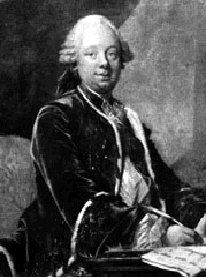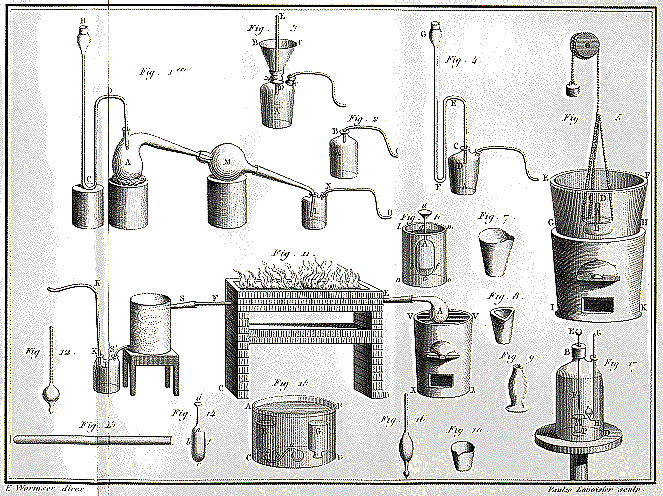
George Ernst Stahl |
During the eighteenth century, the scientific theories that
existed had no scientific basis. The scientists at the time, such as
Aristotle and Stahl, had put forward theories based upon their own
experiments. However they had never considered measuring
the mass of the reactants or that of the products therefore their conclusions
were based purely on qualitative observations and not quantitative ones.
In fact, Lavoisier's teacher, Rouelle, firmly believed that
there were only four elements. This was a popular belief and the four
elements were called 'The Four Elements of Aristotle'. These were as follows:
Air, Earth, Fire and Phlogiston.
|
The latter was Stahl's theory. It was widely accepted and used
as an explanation for the effects of burning a particular material or substance.
According to Stahl's Theory, all metals, fire and coal were rich in
Phlogiston. This invisible and inflammable 'element' provided an
explanation for the fact that a candle extinguished when placed under a
glass jar. More importantly, this theory explained why a metal could be
transformed into a metal oxide when heated.
The chemical reaction which transformed a metal into the metal
oxide was called 'Calcination'. By heating a metal, the metal lost
Phlogiston and therefore transformed into metal oxide often in the form of a
white powder.
CALCINATION:
METAL
----------------> METAL
OXIDE
LOSS OF PHLOGISTON
Once oxidised, the metal had lost its lustre as
well as its ductility. Thus the loss of Phlogiston caused the properties
of the metals to change.
The opposite of Calcination was called
'Reduction'. This chemical reaction required coal: the coal restored
the Phlogiston lost during Calcination and therefore transformed the metal oxide
back into a metal.
REDUCTION
METAL OXIDE ------------------------>
METAL
GAIN OF PHLOGISTON
At first, this logical and plausible
concept appeared to explain the effects of these chemical reactions on metals.
However, shortly after Stahl's discovery, a scientist repeated Stahl's
experiments and noticed a strange phenomena: The mass of the metal oxide
was greater than that of the metal. This appeared to be impossible as the
loss of Phlogiston during Calcination would suggest a decrease in mass.
Furthermore, other scientists had discovered that
mercury oxide could be transformed into mercury without the use of coal ie.
without a source of Phlogiston.
Stahl recognised the fact that there was a discrepancy
between the experimental results and his theory, but he didn't attempt to
explain this anomaly. However,
 Louis
Morveau, a chemist, suggested that Phlogiston had a negative mass and this
concept was accepted by many scientists.
Louis
Morveau, a chemist, suggested that Phlogiston had a negative mass and this
concept was accepted by many scientists.
Despite popular belief in this new theory, Lavoisier was not
convinced that Phlogiston existed as the Phlogiston theory appeared to
contradict all the laws of conservation. Therefore Lavoisier decided to
undertake his own experiments hoping to resolve the Phlogiston problem.

 Louis
Morveau, a chemist, suggested that Phlogiston had a negative mass and this
concept was accepted by many scientists.
Louis
Morveau, a chemist, suggested that Phlogiston had a negative mass and this
concept was accepted by many scientists.